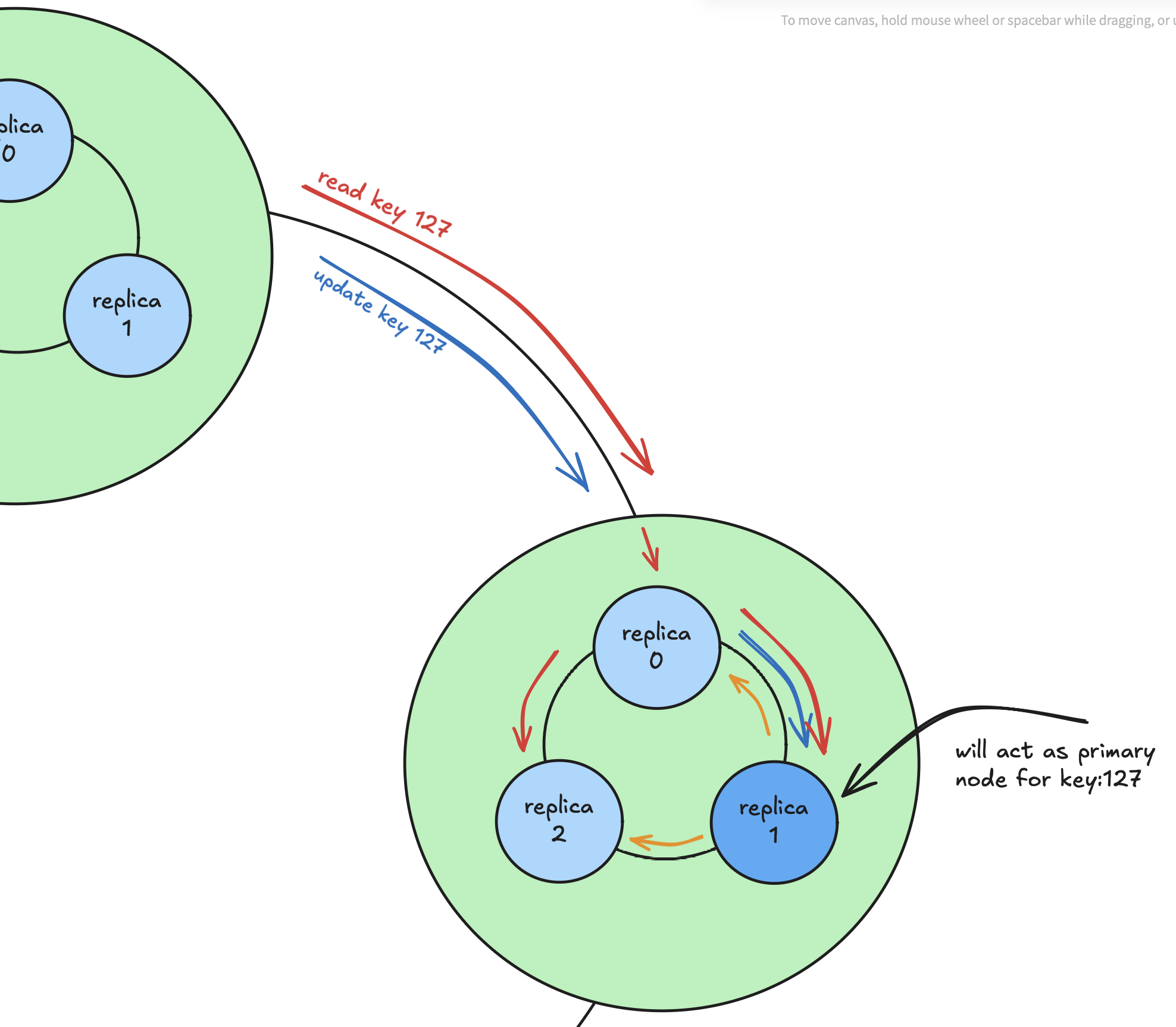Consistent Ring Within a Consistent Ring
Over the past few months, I’ve been diving deep into distributed storage internals — and somewhere along the way, OrangeDB was born. If you haven’t heard of it yet, check orange. This journey led me to explore several lesser-known databases that quietly power critical infrastructure in production environments.
Some highlights:
- Cassandra — a fully leaderless, highly available system with tunable consistency.
- MongoDB — a semi-consistent document store with sharding and replica sets.
- LevelDB / RocksDB — high-performance embedded key-value stores.
- Voldemort / Riak — early pioneers in distributed key-value stores.
Revisiting Existing Designs
Cassandra
Cassandra is completely leaderless — any node can handle reads or writes. Data is eventually replicated using gossip. To ensure consistency, Cassandra uses tunable quorum reads and writes:
- For a cluster with
nreplicas:- A write must be acknowledged by at least
wnodes. - A read must be satisfied by
rnodes. - The constraint
w + r > nensures strong consistency.
- A write must be acknowledged by at least
Features like sloppy quorum, hinted handoff, and read repair further enhance availability. However, this design may result in higher read and write latencies, especially under quorum settings.
MongoDB Sharded Deployment
In a MongoDB sharded cluster:
- The dataset is partitioned across shards.
- Each shard is a replica set with a single primary and multiple secondaries.
- All writes go to the primary of the relevant shard.
- Reads can be routed to the primary or to secondaries depending on the configured read preference.
This design offers strong consistency by default (via the primary) and lower read latency in relaxed consistency modes. However, it relies heavily on leader election (via Raft), which introduces complexity (e.g., split-brain handling, election delays, leadership failover).
Enter OrangeDB

OrangeDB attempts to combine the best of both worlds:
- The scalability and partitioning of MongoDB’s sharded setup.
- The leaderless replication and tunable consistency of Cassandra.
It introduces:
“Consistent Ring Within a Consistent Ring”
- An outer ring of nodes forms the basis for shard selection via consistent hashing.
- Each shard contains an inner ring of replica nodes, also organized using consistent hashing.
This two-layer ring structure enables fine-grained control over placement, replication, and load distribution.
Write Path
- For a key like
k=120, OrangeDB hashes the key to determine the target shard via the outer ring. - Within that shard, the key is again hashed to select a specific replica (let’s say
replica-1) in the inner ring. - All writes for that key go to this designated primary replica — without any leader election.
- That replica then asynchronously replicates the write to its sibling replicas within the shard using gossip-style replication (similar to Cassandra).
This design achieves:
- Write locality per key.
- Leaderless writes without the overhead of leader elections.
- Horizontal scalability by sharding at both levels.
Read Path
Reads can be performed at multiple consistency levels depending on the use case:
- A read first determines the target shard and replica (as with writes).
- Based on the configured consistency level, the system will:
- Query only the primary replica, or
- Query a quorum of replicas, or
- Query all replicas and enforce unanimous agreement.
Read Consistency Levels
OrangeDB supports three read modes:
all
- Queries all replicas of a shard.
- Requires unanimous agreement on the value.
- Strongest consistency, but higher latency.
- Fails if any replica is out of sync.
quorum
- Queries all replicas, but only a majority need to agree.
- Balances availability and consistency.
- Can optionally trigger read repair for divergent replicas.
single
- Reads from the designated primary replica only.
- Fastest option, but assumes the primary is available and up-to-date.
- Risks stale reads or data loss if the replica is unavailable.
What OrangeDB Tries to Solve
OrangeDB vs Cassandra: Simpler, Lower-Latency Writes
OrangeDB avoids quorum-based writes by routing each key to a fixed replica, requiring no coordination during writes.
Why it matters:
- Cassandra needs coordination between
wreplicas (e.g., 2 of 3) for every write. - OrangeDB writes to a single replica and replicates asynchronously — lower latency, less overhead.
Trade-off: Potential for data loss if the primary fails before replication. No immediate durability like Cassandra’s quorum model.
OrangeDB vs MongoDB: No Leader Election, Always Writable
OrangeDB removes the concept of a primary per shard, avoiding Raft-based elections and their downtime.
Why it matters:
- MongoDB pauses writes during primary failover and risks split-brain under partitions.
- OrangeDB uses deterministic key-to-replica mapping — no election, no downtime.
Trade-off: Requires smarter client or routing logic to handle failed replicas gracefully.
Final Thoughts
OrangeDB started as a personal exploration—an educational project driven by curiosity about how distributed storage systems work under the hood. It’s a playground to experiment with ideas inspired by Cassandra, MongoDB, and others, but rethinking some of their core trade-offs.
This project is far from production-ready. There are still many unanswered questions around durability, failure handling, and consistency guarantees. But that’s part of the fun—learning by building and seeing what challenges arise.
If you’ve enjoyed this peek into the inner workings of distributed databases, I hope it sparks your own experiments and deep dives. At the end of the day, OrangeDB is just one step in an ongoing journey to understand and improve how I store and manage data at scale.
Thanks for reading and sharing the curiosity! ✌️